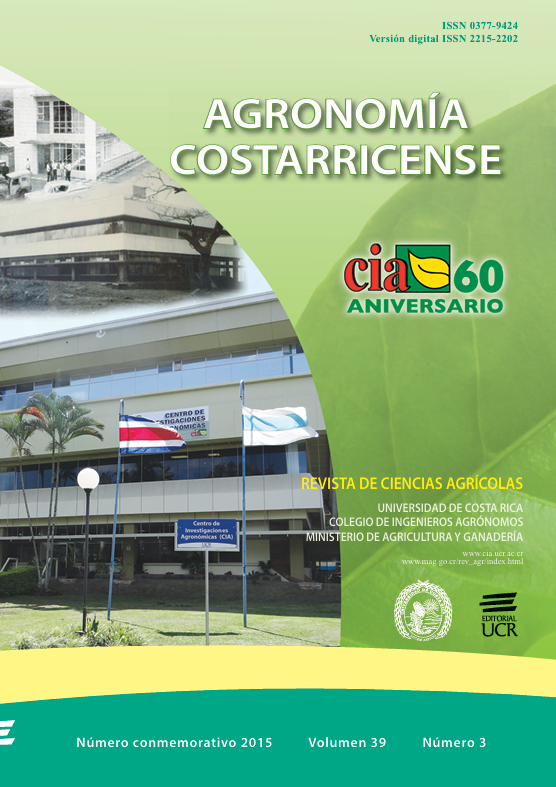Abstract
In order to improve the quality of the fruit, judged at the market as the degree of yellowing of the peel, 2 experiments were performed to evaluate the effect of storage temperature on change in external color of pineapple (Ananas comosus) fruit cv. “Gold Extra Sweet”. The temperatures evaluated were 7.5°C; 10.0°C; 12.5°C and 15.0°C, and their effect on the color change and the chlorophyll content in the peel, respiration rate and parameters of external and internal quality were measured. The fruit was stored at different temperatures for 21 days and then transferred to 18.0°C during 4 additional days. At the end of the storage period, pineapples at 7.5°C showed the highest content of chlorophyll a (200 μg.g-1 f.w) and the lowest degree of external color (0.32-0.70), fruits stored at 15.0°C had the lowest content of chlorophyll a (40 μg.g-1 f.w) and the highest color grade (4.42-5.25). Pineapples stored at 7.5°C showed the lowest respiration rate at 21 days (6.4 ml CO2/kg*h), while fruit stored at 15.0°C had the highest respiration rate (15.8 ml CO2/kg*h). As the storage temperature increased the weight loss and mold growth in the peduncle increased. At the end of storage at 18.0°C, the color advance in the fruits previously stored at 7.5°C was the lowest, while the highest external yellow color developed on the fruits previously kept at 15.0°C. The results suggest that the storage temperature affects chlorophyll degradation and development of external yellow color, which could be useful in the commercial management of pineapple fruit.References
ABDULLAH H., ROHAYA M.A., LATIFAH M.N., SELAMAT M.M., UNDERHILL S. 2002. Respiration rate, ethylene production and chlorophyll content of the fruit and crown of pineapple stored at low temperatures. J. Trop. Agric and Fd Sc. 30(1):99- 107.
AGRIOS G. 2005. Plant pathology. (5 ed). California, USA, Academic Press. 952 p.
BAERT K., VALERO A., DE MELULENAER B., SAMAPUNDO S., MORSHED M., BO L., DEBEVERE J., DEVLIEGHERE F. 2007. Modelling the effect of temperature on the growth rate and lag phase of Penicillium expansum in apples. International Journal of Food Microbiology 118:139-150.
BRAT P., THI HOANG L.N., SOLER A., REYNES M., BRILLOUET J.M. 2004. Physicochemical characterization of a new pineapple hybrid (FLHORAN41 Cv.) Journal of agricultural and food chemistry 52(20):6170-6177.
DERE Ş., GÜNEŞ T., SIVACI R. 1998. Spectrophotometric determination of chlorophyll- A,B and total carotenoids contents of some algae species using different solvents. Turskish Journal of botany 22:13-17.
FAWOLE O.A., OPARA U.L. 2013. Effects of storage temperature and duration on physiological responses of pomegranate fruit. Industrial crops and products 47:300-309.
FONSECA S., OLIVEIRA F., BRECHT J. 2002. Modeling respiration rate of fresh fruits and vegetables for modified atmosphere packages: a review. Journal of food engineering 52:99-119.
GARITA R.A. 2014. La piña. Cartago, Costa Rica, Editorial Tecnológica de Costa Rica. 568 p. GOUGOULI M., KOUTSOUMANIS K.P. 2010. Modelling growth of Penicillium expansum and Aspergillus niger at constant and fluctuating temperature conditions. International Journal of Food Microbiology 140:252-262.
HASSAN A., OTHMAN Z. 2011. Pineapple (Ananas comosus L. Merr.), pp. 194-217. In: E.M. Yahia (eds.). Postharvest biology and technology of tropical and subtropical fruits. WP.
HONG K., XU H., WANG J., ZHANG L., HU H., JIA Z., GU H., HE Q., GONG D. 2013. Quality changes and internal browning developments of summer pineapple fruit during storage at different temperatures. Scientia Horticulturae 151:68-74.
KADER A. 2002. Postharvest technology of horticultural crops. University of California. Agricultural and natural resources. Third edition. Oakland, California. 535 p.
KAYS S. 1997. Postharvest physiology of perishable plant products. Georgia, USA, Exon press. 532 p.
LIU C., LIU Y. 2014. Effects of elevated temperature postharvest on color aspect, physiochemical characteristics, and aroma components of pineapple fruits. Journal of food science 79(12):2409-2414.
MAZUR S.P., NES A., WOLD A.B., REMBERG S.F., MARTINSEN B.K., AABAY K. 2014. Effects of ripeness and cultivar on chemical composition of strawberry (Fragaria x ananassa Duch.) fruits and their suitability for jam production as a stable product at different storage temperature. Food chemistry 146:412-422.
PAULL R.E., CHEN C.C. 2003. Postharvest physiology, handling and storage of pineapple, pp. 253-279. In: D.P. Bartholomew, R.E. Paull and K.G. Rohrbach (eds). The pineapple: Botany, production and uses. CABI publishing.
ROBERTS S. 2009. Fruit pigmentation studies. Master of science. Stellenbosch, South Africa, Stellenbosch University. 106 p.
SOLANO J. 2015. Efecto del tiempo transcurrido entre cosecha e inicio de enfriamiento en túneles de aire forzado, sobre la vida útil de almacenamiento de piña (Ananas comosus) Var. Dorada Extra Dulce, en dos zonas de Costa Rica. Tesis de licenciatura, Universidad de Costa Rica, San José, Costa Rica. 92 p.
SYMONS G.M., CHUA Y.J., ROSS J.J., QUITTENDEN L.J., DAVIES N.W., REID J.B. 2012. Hormonal changes during non-climacteric ripening in strawberry. Journal of experimental botany 63(13):4741-4750.
TIETEL Z., LEWINSOHN E., FALLIK E., PORAT R. 2012. Importance of storage temperatures in maintaining flavor and quality of mandarins. Postharvest biology and technology 64:175-182.
UMAÑA G., LORÍA C.L., GÓMEZ J.C. 2011. Efecto del grado de madurez y las condiciones de almacenamiento sobre las características fisicoquímicas de la papaya híbrido Pococí. Agronomía Costarricense 35(2):61-73.
WANG H.C., HUANG X.M., HU G.B., YANG Z., HUANG H.B. 2005. A comparative study of chlorophyll loss and its related mechanism during Fruit maturation in the pericarp of fast and slow degreening litchi pericarp. Scientia Horticulturae 106:247-257.


